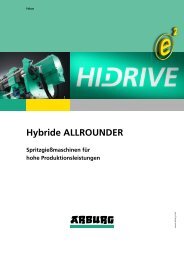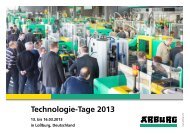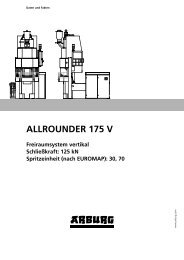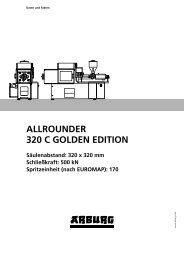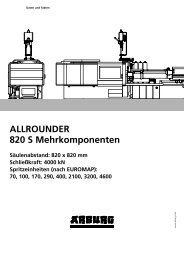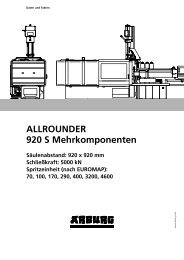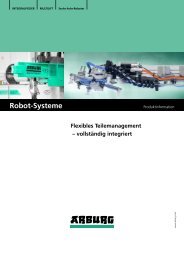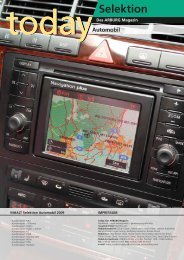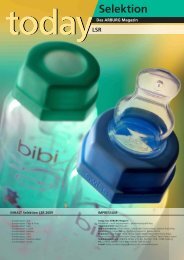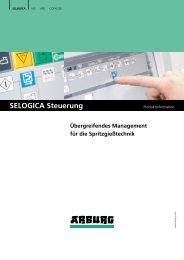GB - Arburg
GB - Arburg
GB - Arburg
You also want an ePaper? Increase the reach of your titles
YUMPU automatically turns print PDFs into web optimized ePapers that Google loves.
The perfect twist:<br />
Unscrewing using<br />
the electric<br />
core pull control<br />
Precision and repeatability<br />
are in constant demand,<br />
especially when<br />
unscrewing high quality<br />
threads on technical injection<br />
moulded parts. Using<br />
unscrewing units with<br />
servo-electric drive mechanisms,<br />
it is possible to<br />
achieve very precise position<br />
regulation in all ejection<br />
movements.<br />
The basis for this is the electric<br />
core pull control, which can be used<br />
for all applications that are traditionally<br />
associated with the hydraulic<br />
core pull. The main difference<br />
lies in each movement being<br />
controlled servo-electrically. In conjunction<br />
with the absolute system<br />
of measuring used, it is possible<br />
to achieve substantially better positioning<br />
accuracy. As well as this,<br />
drive is possible independently of<br />
the hydraulic axes<br />
on the machine,<br />
meaning it can be<br />
operated at the<br />
same time as all<br />
other machine<br />
movements.<br />
Complete integration<br />
in the SELOGICA<br />
machine control system via a standardised<br />
interface makes the combination<br />
look even more interesting.<br />
The individual movements can<br />
be programmed in directly and precisely<br />
using the system's own screen<br />
displays – no mechanical adjustment<br />
on the mould itself is necessary.<br />
The type of axis movement<br />
required can be switched between<br />
linear and rotating movement, that<br />
is between power, speed and path or<br />
torque, rev speed and rotation. Even<br />
if the user installs an additional, intermittent<br />
linkage, the SELOGICA<br />
machine control system<br />
recalculates all<br />
the parameters involved<br />
once the transmission<br />
ratio has been input.<br />
As well as the very precise position<br />
regulation and repeatable accuracy,<br />
there are other benefi cial<br />
factors to its use in unscrewing<br />
units: a higher maximum torque rating<br />
and the option of trouble-free<br />
programming for various different<br />
steps. That means that intermittent<br />
stops, etching of the thread with<br />
the mould closed or continuous rotation<br />
can be programmed directly.<br />
Unscrewing unit with servo-electric<br />
drive: precisely programmable using the<br />
electric core pull control.<br />
Precision ejection: thermostat with internal and external threads.<br />
All functionalities are stored together<br />
with the corresponding mould<br />
data record, meaning that when<br />
a mould is changed, all the relevant<br />
data is immediately available.<br />
Improved operator comfort, shorter<br />
set-up times and better security<br />
against operating errors are the immediate<br />
advantages of this shared<br />
data record.<br />
ARBURG technology<br />
The big question:<br />
how is the 630 S<br />
getting on?<br />
It was hoped that a follow-up<br />
telephone campaign<br />
by ARBURG, aimed<br />
at customers already using<br />
the 630 for production in<br />
their machine shops, would<br />
shed a little light on this<br />
question. "The reason is<br />
simple," as Eberhard Lutz,<br />
head of domestic sales, says:<br />
"Prior to this, we had received<br />
no feedback from<br />
the customers about our big<br />
ALLROUNDER or customer's<br />
experiences of its use in the<br />
fi eld. And that can be positive<br />
as well as negative!"<br />
To clear this up straight away:<br />
the results of the representative<br />
ARBURG survey were very nearly<br />
all positive. The machines are<br />
either being used for testing purposes<br />
or are already fully integrated<br />
and being fully exploited<br />
in production. The companies reported<br />
no problems with the basic<br />
machine technology or the<br />
special features such as the platen<br />
adjustment.<br />
Apart from two very minor<br />
leaks there were no complaints<br />
whatsoever. These diffi culties can<br />
be put down to "teething troubles"<br />
and could be rectifi ed very<br />
swiftly as a result. This reassuringly<br />
very positive fi rst feedback<br />
suggests that even the biggest<br />
machine ever from the "S Class"<br />
has been received extremely well<br />
by the market.<br />
It should be even more interesting<br />
when additional processing<br />
procedures and new features<br />
are added, making its application<br />
even more universal. The keywords<br />
in this context are "multi-component<br />
injection moulding"<br />
and "optimised hydraulics<br />
for faster drive movements".<br />
9



